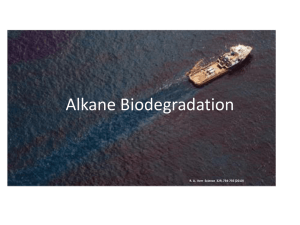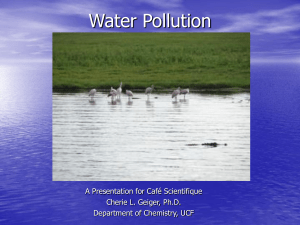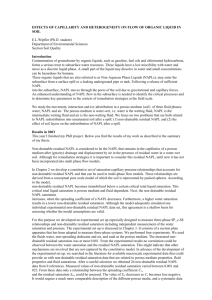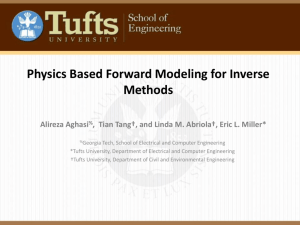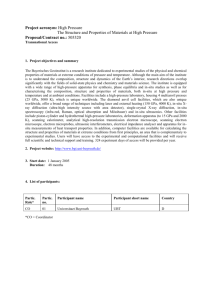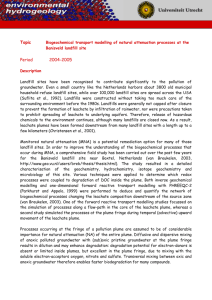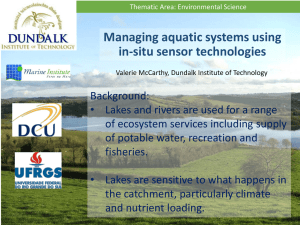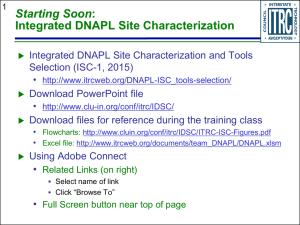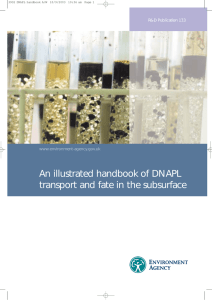08Remed - Rice University
advertisement
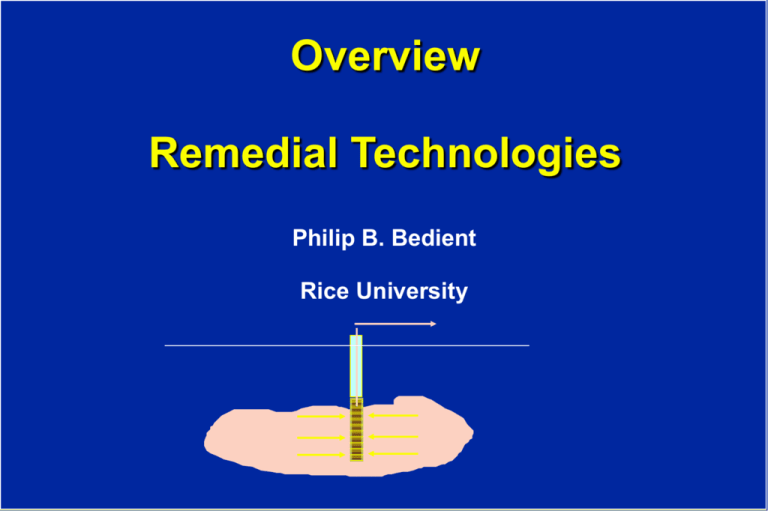
Overview Remedial Technologies Philip B. Bedient Rice University How Remediation Technology Evolves Cost-Effective Technology Proven Technology Large-Scale Field Trials Emerging Technology Experimental Technology Uncontrolled Pilot Trials Prototypes and Controlled Field Experiments Bench Studies Concept / Problem Identification CONCEPTS Source: Cherry, 1992 Original Paradigm: 1980s Groundwater Pump and Treat Will Remediate Sites Bad News Conc ? Cleanup Standard Time EPA’s 19 Site Study • 19 Sites With Five Years of Operating Data • Restoration “Slower Than Expected” • Three Causes: Hydrology, Design Flaws, NAPLs • Update: At 20 of 24 Sites, DNAPL Probably Present Residual saturation of LNAPL in soil from spill Dissolved contaminant plume Free phase layer in saturated zone Ground water flow Forming Residual NAPL Snap-Off Mechanism: Other Mechanisms: Bypass, Etc. NAPLs and Capillary Forces NAPL NAPL NAPL Residual vs. Free-Phase DNAPL Free-Phase DNAPL Residual DNAPL Residual NAPL: Long-Term Source • Can’t Remove Residual • Dissolves Slowly • Large Mass Compared to Dissolution Rate Recovering LNAPL Separator Sand Pack Screen Pump DNAPL Pool Saturated Zone Recovering LNAPL: Other Configurations Dual Recovery Wells Pump Cans Skimmers Adsorbants DNAPL Pool Trenches DNAPL Conceptual Model DNAPL Entry Zone Residual DNAPL Sand Fractured Clay Sand Dissolved Phase Plume DNAPL Pool Recovering DNAPL DNAPL / Water Separator Sand Pack Pump Screen DNAPL Pool Sump Saturated Zone Impervious Barrier DNAPL Pumping Design Process • Choose Location of DNAPL Wells • Select Pumps and Materials • Assess EOR Technologies – – – – Vacuum-Enhanced Pumping Waterflooding Surfactants Steam • Design Treatment System Remediation Technologies • Introduction - Why Are We Here • Product Removal and Source Control • Groundwater pump and treat • Remedial Technologies in Use Pump-and-Treat (Dissolution) • Dissolves Residual NAPL • Key Concept: Number of Pore Volumes • Takes a Long Time Applicability of Dissolution of NAPLs • NAPLs in Saturated Zone • NAPL with Very Soluble Components • Sites With Low Amounts of NAPL • Highly Permeable Aquifers Proven/Emerging Remediation Technologies • Excavation and Disposal / Treatment • Soil Vapor Extraction (SVE) / Bioventing • In-Situ Biodegradation / Oxygen Releasing Compounds • Air Sparging • Barriers • Containment • RBCA / Natural Attenuation Excavation and Disposal / Treatment Haul To Off-Site Landfill On-Site or Off-Site Thermal Treatment On-Site Physical / Biological Treatment Applicability of Excavation • Standard Construction Practice to 25 Feet Depth • Dewatering Required if Below Water Table • Unconsolidated Material • Best Technology for Small Volumes Soil Vapor Extraction Air / Vapor Manifold Blower or Vacuum Pump Vapor Treatment System (Where Required) Clay Grout Seal Screen Sand Pack Contaminated Soils Water Table Applicability of SVE Vapor Pressure (mm Hg) Likelihood of Success Soil Air Permeability 104 Butane 103 Benzene 102 Xylene 101 100 10-1 Aldicarb Very Likely Somewhat Likely HIGH (Coarse Sand / Gravel) MEDIUM (Fine Sand) 10-2 LOW 10-3 (Clay or Silt) 10-4 Less Likely Source: CDM, 1988 Design Basis Information: SVE • Air Permeability – Estimated from Soil Properties – Measured With Test in Field • Contaminant Characteristics – DNAPL Composition – Volatility (Vapor Pressure, Henry’s Law Coefficient) • Air Flow – Stratigraphy – Need for Impermeable Cap – Water Table and Need for Pumping SVE Design Process • Choose Number of Vapor Extraction Wells • Choose Well Spacing, Inlet Wells, Seals • Design Well Screens and Construction • Remember Vapor Treatment • Check for Groundwater Upwelling Source: Johnson 1990 Bioventing If Air Injection Rate is Slow Enough No Vapor Treatment Is Needed Ref.: Hinchee Blower Unsaturated Zone Saturated Zone Slowly Adds Oxygen to Unsaturated Zone for Biodegradation Bioventing Process Overview • Inject Air Into Unsaturated Zone • Primary Process: Aerobic In-Situ Biodegradation • Injection Is Slow to Minimize Release of Organics to Surface or Buildings • No Need to Treat Vapors Bioventing Design Approach • In-Situ Permeability Test • In-Situ Respiration Test (24 - 80 hrs) • Install Wells and Inject – – – – – Ususally 2 in. PVC Vent Wells Water Table < 20 ft: Screen 10 - 20 ft Water Table > 20 ft: Through Contaminated Zone Spacing: 5 to 60 ft, Depends on Depth and Soil Type Injection Rate: Variable Proven/Emerging Remediation Technologies • Excavation and Disposal / Treatment • Soil Vapor Extraction (SVE) / Bioventing • In-Situ Biodegradation / Oxygen Releasing Compounds • Air Sparging • Barriers • Containment • RBCA / Natural Attenuation In-Situ Biodegradation Oxygen Addition To: • Treatment • Treatment / Recycle • Recycle Injection Well Nutrient Addition Recovery Well DNAPL In-Situ Biodegradation Zone Applicability of In-Situ Biodeg. • Sites With Non-Chlorinated Compounds – BTEX – Creosote Sites (Napthalene, PAHs) – Coal Tar • Sites With Depressed Oxygen in Plume Area • Aquifers With High Permeability In-Situ Biodeg. Design Process • Estimate Total NAPL Mass • Calculate Required Mass of Oxygen to Be Injected – Yield: 2 gms Oxygen for 1 gm Hydrocarbon • Select Method to Add Oxygen to Injection Water – Bubble Air in Injection Water – Pure Oxygen – Hydrogen Peroxide • Calculate Water Needed • Size Recovery Well System ~ 10 mg/l ~ 25 mg/l ~ 100 mg/l (?) Oxygen Releasing Compound (ORC) • Magnesium peroxide compound activated by moisture • “Patented technology” controls and prolongs release • Moderate pH levels • Pure oxygen source (more dissolved O2 than sparging) Air Sparging Air Compressor Blower Vapor Treatment SVE Well NAPL Tiny Bubbles Volatilizes Organics and Promotes In-Situ Biodeg. Air Sparging Process Review • Air Pathway – Forms A Few Small Channels – Remarkably Sensitive to Heterogeneities – Air Flow From Top of Screen • Remediation Processes – Volatilization of NAPLs – Air Stripping of Dissolved Organics – Oxygenation of Water Enhances In-Situ Biodeg. Air Sparging Design Issues • Well Configuration – – – – Usually 1-2 inch PVC Wells, 2-5 ft Screens Spacing: 10 - 20 ft (Billings) Spacing: 50 - 75 ft (Brown) Spacing: 5 - 15 ft (Newell) • Injection Pressure: 1-10 psig • Air Flowrates – < 10 SCFM per well – Helps to Cycle (Hours, Not Days) Air Channel Pattern at Moderate Air Injection Rate in a Medium Mixture of Two Bead Sizes With 38% of 0.75 mm and 62% of 0.3 mm Overburden with 4 mm beads Mixture of two size beads Source: Ji et al, 1993 Air Channels at Low Air Injection Rate in 0.75 mm Uniform Bead Medium Overburden with 4 mm beads 0.75 mm beads Source: Ji et al, 1993 Short Circuiting in Air Sparging System Air Flow Contaminated Zone Low Permeability Zone Air bubble Proven/Emerging Remediation Technologies • Excavation and Disposal / Treatment • Soil Vapor Extraction (SVE) / Bioventing • In-Situ Biodegradation / Oxygen Releasing Compounds • Air Sparging • Barriers • Containment • RBCA / Natural Attenuation Physical Barriers • Purpose – Prevent Outward Migration of Organics – Reduce Inflow of Groundwater • Design – Types – Keyed Into Confining Unit – Partial vs. Complete Enclosures • Construction – Routinely Installed Down to 50 feet – Cost: ~ $ 10 - $ 20 per sq. ft. for Slurry Wall Cutoff-Wall – Keyed into Clay LOW PERMEABILITY WALLS AQUITARD FL OW DNAPLs AQUIFER Cutoff Wall – Hanging LOW PERMEABILITY WALLS AQUITARD FL OW DNAPLs AQUIFER Hydraulic Containment Pumping Well Streamlines Plume Capture Zone • Design Methods – Javendahl Capture Zone Curves – Computer Models • Operational Factors – Well Efficiency – Seasonal / Annual Effects Hydraulic Containment With Slurry Wall 0' Slurry Wall Well Slurry Wall PITS Pits Frac. Clay 35' Aquifers DNAPL Unfract. Clay 70' Drinking Water Aquifer Funnel and Gate Systems Funnel Plan View Contaminant Plume Plume Without Critic al Contaminants Gate Keyed Gate Fill Vertical Slice Aquifer Plume Treated Plume Reac tive medium SKIMMING NAPLs IN SOURCE ZONES • Interceptor trenches - collect free product • Single pumping system • Dual pumping system • Combined water and product pumps • Oil water separator at surface Typical NAPL Migration Pattern Interceptor Trench for DNAPL TREATMENT UNIT EXTRACTION BACKFILL CONTAMINATION ZONES GRAVEL BACKFILL TRENCH NAPL PLUME FROM FUEL SPILL NAPL RECOVERY SYSTEM TWO WELLS TWO PUMPS NAPL RECOVERY SYSTEM ONE WELL TWO PUMPS Natural Attenuation: A New Approach Horizontal Wells Basic Philosophy: We Know It is Difficult to Remove All Contaminants..... But We Can Predict What Happens to Them. Overview of Natural Attenuation Destruction of Contaminants via Biodegradation Observed at Numerous Field Sites Studied in Detail at Several Research Sites Policy & Guidance Now Recognize Natural Att. Scientific Understanding is Rapidly Increasing Natural Attenuation Under RCRA Proposed Subpart S Preamble Natural Attenuation Could Be the “Most Appropriate” Approach At Many Sites and May “Play a Major Role” Conditions: • Standards Achieved in a Reasonable Time • Likelihood of Exposure Is Minimal Obstacles to Natural Attenuation Associated with No Action Preference for Zero Plume Growth Preference for Rapid Remediation NATURAL ATTENUATION Evidence of Natural Attenuation Criteria: Plume stable or shrinking Plume is shorter than would be expected Depletion of measurable electron acceptors (OXYGEN, NITRATE OR SULFATE) observed Metabolic by-products (FERROUS IRON AND METHANE) observed Presence of active, heterotrophic bacteria Evidence of Natural Attenuation No BTEX BTEX BTEX Oxygen Dissolved Oxygen No Oxygen Map and Perform Mass Balance on Electron Acceptors and Byproducts: • • • • • Oxygen Nitrate Iron Sulfate CO2 RISK-BASED CORRECTIVE ACTION GROUNDWATER SERVICES, INC. John A. Connor, P.E. Charles J. Newell, Ph.D., P.E. J. Peter Nevin Risk Assessment Fundamentals Risk Management Transport SOURCE RECEPTOR Minimize risk by preventing exposure. Risk-Based Corrective Action Procedures TRADITIONAL APPROACH Remedial Investigation RISK-BASED APPROACH Remedial Investigation Risk Assessment Corrective Measure Study Corrective Measure Study Corrective Measure Implementation Corrective Measure Implementation GRBCA (Gut-Feel Risk Based Corrective Action) BAD NOT SO BAD Baseline Risk Calculation Exposure x Exposure x Toxicity Concentration Factors Source Conc. Calculation = Health Risk Groundwater Services RBCA Tool Kit www.gsi-net.com Exposure x Exposure x Toxicity Concentration Factors SOURCE CLEANUP LEVEL Calculation = Health Risk ASTM Guide for RBCA ASTM RBCA Program Release Notification Site Assessment Site Classification and Interim Response Tiered RBCA Evaluation Remedial Action Compliance Monitoring Site Classification and Response: Classification: Classify site per immediacy and magnitude of risk, based on current “snap shot.” Response: Implement appropriate response action for each class. GOAL: Control near-term hazards as site evaluation proceeds. Target resources toward high-risk sites. No Further Action Groundwater Exposure Pathway 3) Soil Leaching to Groundwater: Ingestion OnSite Affected Soil OffSite Drinking Water Well Affected Groundwater 4) Dissolved or Free-Phase Groundwater Plume: Ingestion = Drinking Water Well Affected Groundwater Potential Point of Human Exposure (i.e., on-site or off-site). Proven/Emerging Remediation Technologies • Excavation and Disposal / Treatment • Soil Vapor Extraction (SVE) / Bioventing • In-Situ Biodegradation / Oxygen Releasing Compounds • Air Sparging • Barriers • Containment • RBCA / Natural Attenuation
